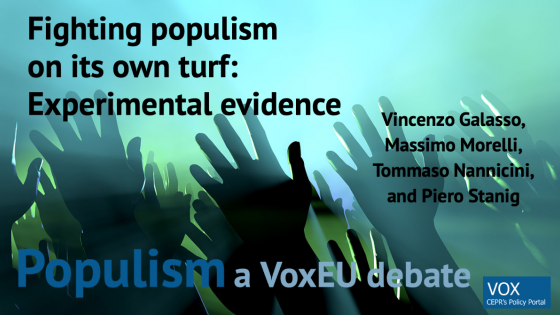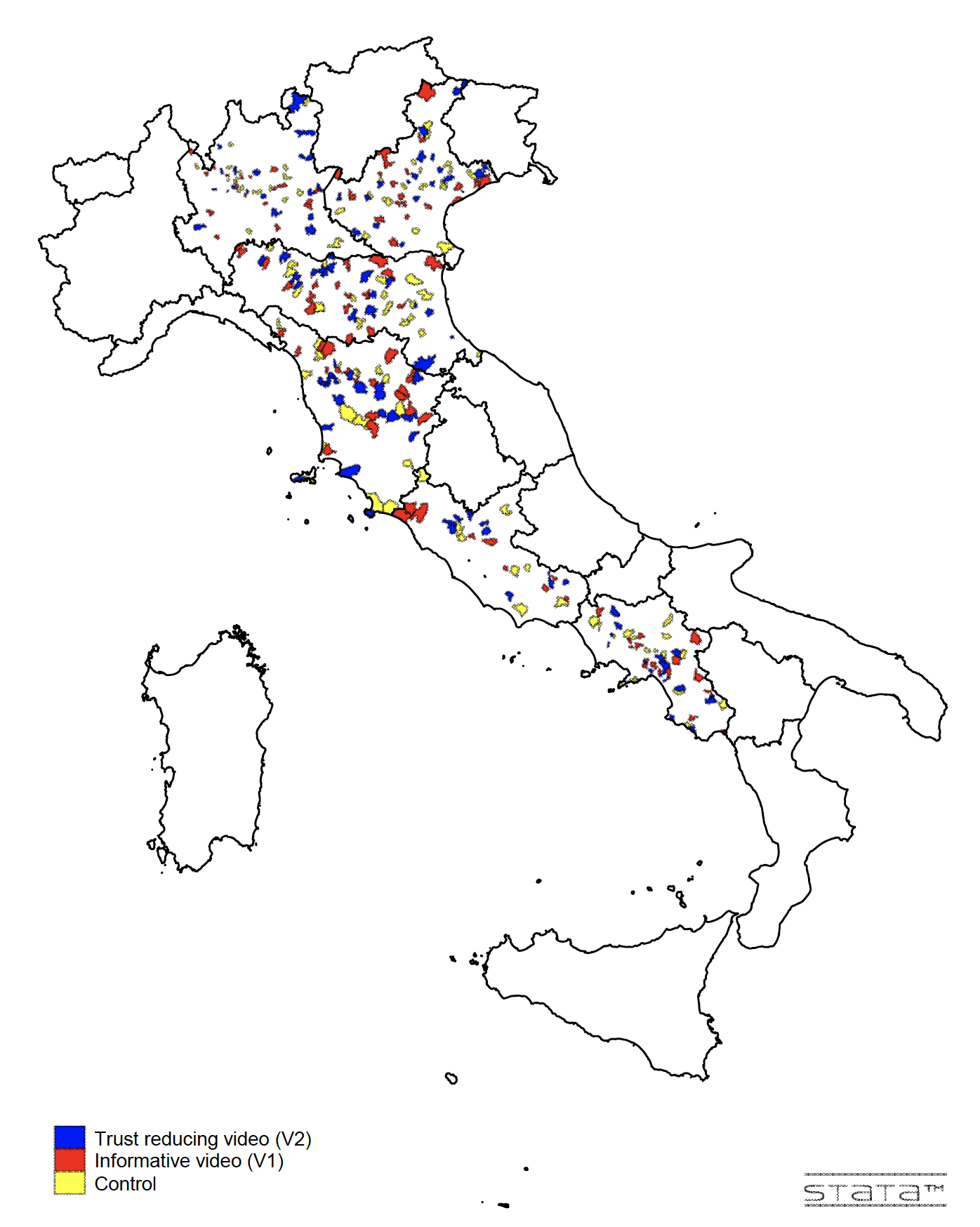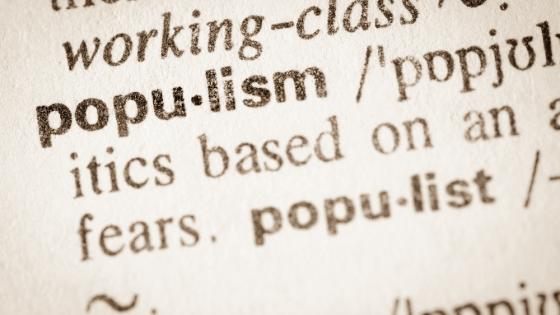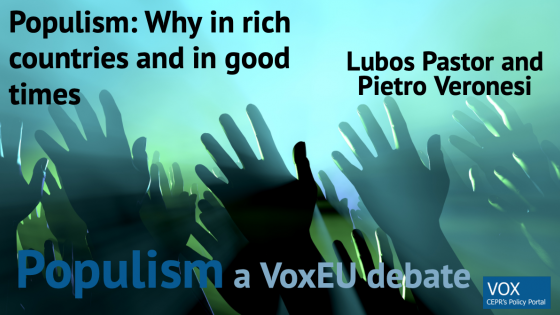Populist parties have been posing an extraordinary challenge to traditional parties. Populists have managed to force issues that are largely beneficial to them - such as migration – onto the political agenda, impose a divisive communication style (‘us versus them’), and move the public discussion onto social media, such as Twitter. So far, traditional parties have struggled to find adequate responses. Several domains of politics are potentially involved, including economic policies, issue ownership, selection of politicians (Aiginger 2019, Fuest, 2019, Pastor and Veronesi 2019). But the most distinctive element of populism is arguably its communication style (Mudde and Kaltwasser 2017, Guriev and Papaioannou 2020).
Political pundits do advise traditional parties on which communication strategies to use to combat populism (Kendall-Taylor and Nietsche 2020). Language and framing linking identity and partisanship are to be avoided, as are efforts to educate the other side of the electorate. Traditional parties should instead re-energise their own grassroots mobilisation and integrate their platform policies into a unifying and aspirational narrative. In fact, canvassing using non-judgementally exchanging narratives in interpersonal conversations reduces the exclusionary attitudes – towards immigrants – that often present among populist voters (Kalla and Broockman 2020). Yet, these strategies are costly and time consuming.
Potentially, traditional parties could also adopt an opportunistic communication style that relies on a blame-attribution, dispositional rhetoric (Busby et al. 2019). But can this communication style employed – and, to certain degree, introduced – by populist parties be effectively used by the traditional parties to combat populism (Akkerman et al. 2014, Dai and Kustov 2022)? Admittedly, populist-style political ads may reduce turnout and breed disenchantment (Chong et al. 2015). Yet, strategies aimed at demobilising voters of opposing parties may potentially be more effective than plans to persuade them (Kalla and Broockman 2018) or efforts to get out the vote among the party’s own core electorate (Green and Gerber 2019).
A field experiment: The Italian referendum on reducing the number of Members of Parliament
The constitutional referendum held in September 2020 on the substantial reduction (from 945 to 600) of the total number of Members of Parliament (MPs) in the two Chambers of the Italian Parliament represents the perfect testing ground for the communication strategies of traditional parties. The reduction of MPs was initiated and strongly supported by the populist parties – the Five Star Movements and the League. Indeed, the motivation for this constitutional reform was part of a populist narrative: reducing the seats for the political elites in order to save people money. The referendum was lopsided, with the public opinion largely in favour of reducing the number of MPs (70% for ‘Yes’ versus 30% for ‘No’).
Which communication strategies should the traditional parties have implemented during an electoral campaign on such a populist issue? Using electoral material from a Referendum Committee opposing the reduction of MPs, in a recent paper (Galasso et al. 2022) we compare the electoral effectiveness of two alternative strategies. A ‘win the argument’ strategy aims at persuading voters by deconstructing the populist message. Information on the negligible cost savings achieved by reducing the number of MPs, and on the possible negative consequences for the democratic representativeness of Parliament, is released to voters. A ‘use the same weapons’ strategy aims at demobilising populist voters by reducing the credibility of populist parties. This strategy involves a direct attack on the politicians promoting the reduction of the number of MPs, explicitly highlighting their opportunistic or illegal behaviour. The electoral material consisted of two video advertisements – one following each electoral strategy. These two videos differed in their tone and message, but were identical in their length and graphics. Both videos (available here) lasted 30 seconds.
Programmatic advertisement: Almost a million impressions
These two videos were shown in 200 mid-sized municipalities in six large regions by using programmatic advertisement (PA). PA is an automated transaction of buying and selling advertising online, through the algorithmic software of an exchange platform in a fraction of a second. A publisher lists the ad space for a particular viewer, who is currently on its webpage, on the supply-side platform (SSP). This listing contains a wealth of information on the site, the ad space, and – thanks to cookies on the viewer’s device – the geographic location, demographics, and interests of the viewer. Demand-side platforms (DSPs) review this information to match users with the budget and targeting parameters of their advertisers. In real time, DSPs make bids on behalf of their advertisers. The SSP picks the winner and shows the ad to the user on the publisher’s site. Programmatic advertising has several advantages. It allows for targeting users on a granular level, with the right message, in the right place, at the right time and on several devices, such as mobiles, desktops, tablets, and TVs. Hence, budget waste due to reaching likely uninterested viewers can be eliminated and feedback on the performance of each ad can be obtained in real time.
The two electoral videos were displayed as non-skippable pre-rolls on a large host of websites – news, business, sports, games, food, etc. Our budget allowed us to fund around one million impressions in total. We instructed the professional company to use a bidding strategy that would allow each municipality to receive a number of impressions proportional to its size. The targeted ratio of impressions to citizens was around 57%. IN the end, almost 850,000 impressions were deployed and almost 600,000 individuals were reached – avoiding double counting.
The municipalities for the field experiment were selected among those with between 2,500 and 15,000 inhabitants and with sufficient digital penetration, in order for the electoral campaign to be effective. Within each of the six regions, triplets of municipalities were formed by minimising a measure of distance on relevant political characteristics and randomly selected to obtain 300 municipalities (i.e. 100 triplets). Within each triplet, municipalities were randomly assigned to be treated with one of the two videos or to be a control. Figure 1 shows the treated and control municipalities in a map of Italy.
Figure 1
The cost effectiveness of dissuading voters
Programmatic advertisement was quite effective – 59% of the viewers watched the videos until the end (i.e. 30 seconds) and three quarters watched them for at least 15 seconds. Some differences between the two videos however, however. The video with a direct attack on the credibility of the populist politicians was more effective in capturing viewers’ attention than the video providing the partisan informational content. The ‘use the same weapons’ strategy was also more successful than the ‘win the argument’ strategy in affecting the electoral results. The video attacking the credibility of the populist politicians induced a reduction in turnout rate of almost 2 percentage points – corresponding to a drop of 3.3% in the total number of votes. This demobilising effect was stronger among potential supporters of the constitutional reforms (‘Yes’ voters). In fact, the associated reduction in the ‘Yes’ vote share was around 0.5 percentage points. These estimates are consistent with a 4% reduction in the number of ‘Yes’ votes and with a 1.7% reduction in the number of ‘No’ votes. The ‘use the same weapons’ strategy was thus very effective in demobilising voters. The persuasion rate (DellaVigna and Gentzkow 2010) to abstain is equal to 11.2%, while the persuasion rate to oppose the reform (i.e. vote ‘No’) is 2.6%.
The persuasion rates on the abstentions are in line with those found in the ‘get out the vote’ literature using canvassing (Pons 2018, Green et al. 2003) or the TV (Della Vigna and Kaplan 2007, Enikolopov et al. 2011). Yet, the costs are quite smaller. According to Green and Gerber (2019), the cost per additional person induced to vote – using door-to-door, phone or election festival days – is at least €30. According to our experiment, the cost of dissuading one person from voting associated with showing the ‘use the same weapons’ video through programmatic advertisement amounts to only €2. Of course, having traditional parties exploiting this ‘use the same weapons’ strategy may have different costs in terms of increasingly toxic messages during the electoral campaign and a reduction in political participation, which would add to the existing costs of populism (Funke et al. 2021). However, in terms of campaign implications, our findings suggest that traditional parties, when devising their strategy to (best) respond to populist parties on populist issues, should also consider demobilisation rather than persuasion.
References
Aiginger, K (2019), “Populism: Roots, consequences, and counter strategy”, VoxEU.org, 20 April.
Akkerman, A, C Mudde and A Zaslove (2014), “How populist are the people? measuring populist attitudes in voters”, Comparative Political Studies 47(9): 1324–1353,.
Busby, E C, J R Gubler and K A Hawkins (2019), “Framing and blame attribution in populist rhetoric”, The Journal of Politics 81(2): 616–630.
Chong, A, A L De La O, D Karlan and L Wantchekon (2015), “Does corruption information inspire the fight or quash the hope? A field experiment in Mexico on voter turnout, choice, and party identification”, The Journal of Politics 77(1): 55-71.
Dai, Y and A Kustov (2022), “When do politicians use populist rhetoric? populism as a campaign gamble”, Political Communication, published online, pp. 1–22.
DellaVigna, A and M Gentzkow (2010), “Persuasion: empirical evidence”, Annual Review Economics 2(1): 643–669.
DellaVigna, S and E Kaplan (2007), “The Fox News effect: Media bias and voting”, The Quarterly Journal of Economics 122(3): 1187–1234.
Enikolopov, R, M Petrova and E Zhuravskaya, (2011), “Media and political persuasion: Evidence from Russia”, American Economic Review 101(7): 3253–85.
Funke, M, M Schularick and C Trebesch (2021), “The cost of populism: Evidence from history”, VoxEU.org, 16 February.
Fuest, C (2019), “How serious politics must counter populism”, VoxEU.org, 4 June.
Galasso, V, M Morelli, T Nannicini and P Stanig (2022), “Fighting Populism on Its Own Turf: Experimental Evidence”, CEPR Discussion Paper 17380.
Green, D P and A S Gerber (2019), Get out the vote: How to increase voter turnout, Brookings Institution Press.
Green, D P, A S Gerber and D W Nickerson (2003) “Getting out the vote in local elections: Results from six door-to-door canvassing experiments”, The Journal of Politics 65(4): 1083–1096,.
Guriev, S and E Papaioannou (2020), “The political economy of populism”, available at SSRN 3542052.
Kalla, J L and D E Broockman (2018), “The minimal persuasive effects of campaign contact in general elections: Evidence from 49 field experiments”, American Political Science Review 112(1): 148–166.
Kalla, J L and D E Broockman (2020), “Reducing exclusionary attitudes through interpersonal conversation: Evidence from three field experiments”, American Political Science Review 114(2): 410-425.
Kendall-Taylor, A and C Nietsche (2020). Combating populism: A toolkit for liberal democratic actors, Center for a New American Security.
Mudde, C and C R Kaltwasser (2017), Populism: A very short introduction, Oxford University Press.
Pastor, L and P Veronesi (2019), “Populism: Why in rich countries and in good times”, VoxEU.org, 12 December.
Pons, V (2018), “Will a five-minute discussion change your mind? a countrywide experiment on voter choice in France”, American Economic Review 108(6): 1322–63.








